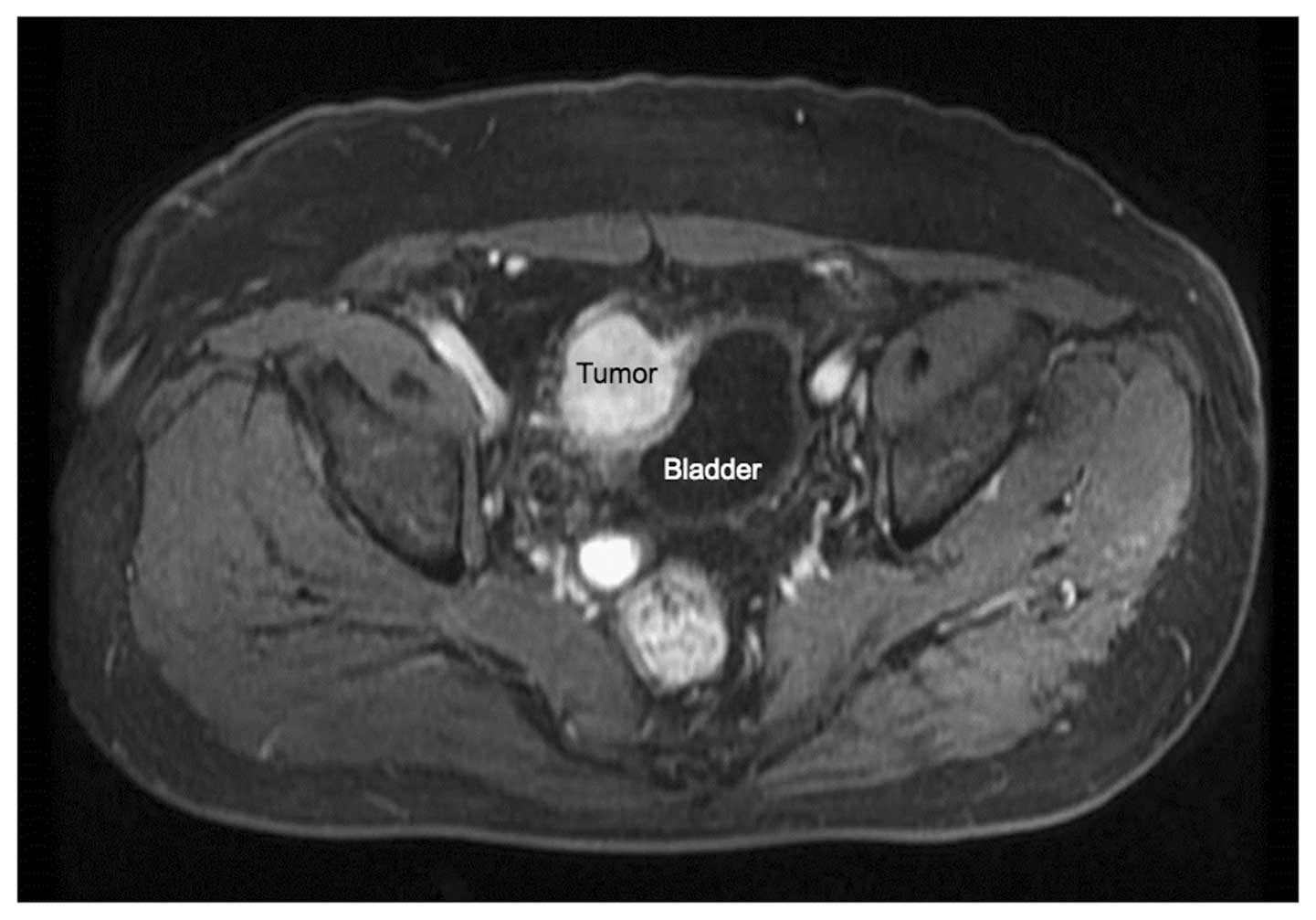|
1
|
Mettlin C, Priore R, Rao U, Gamble D, Lane
W and Murphy P: Results of the national soft-tissue sarcoma
registry. J Surg Oncol. 19:224–227. 1982. View Article : Google Scholar : PubMed/NCBI
|
|
2
|
Singer S, Maki RG and O'Sullivan B: Soft
tissue sarcoma. Cancer: Principles and Practice of Oncology Primer
of the Molecular Biology of Cancer (9th). DeVita VT Jr, Lawrence TS
and Rosenberg SA: (Philadelphia, PA). Lippincott Williams &
Wilkins. 1533–1577. 2011.
|
|
3
|
Fernández-Ruiz M, Rodríguez-Gil Y,
Guerra-Vales JM, Manrique-Municio A, Moreno-González E and
Colina-Ruizdelgado F: Primary retroperitoneal liposarcoma Clinical
and histological analysis of ten cases. Gastroenterol Hepatol.
33:370–376. 2010. View Article : Google Scholar : PubMed/NCBI
|
|
4
|
Vijay A and Ram L: Retroperitoneal
liposarcoma: A comprehensive review. Am J Clin Oncol. 38:213–219.
2015. View Article : Google Scholar : PubMed/NCBI
|
|
5
|
Singer S, Corson JM, Demetri GD, Healey
EA, Marcus K and Eberlein TJ: Prognostic factors predictive of
survival for truncal and retroperitoneal soft-tissue sarcoma. Ann
Surg. 221:185–195. 1995. View Article : Google Scholar : PubMed/NCBI
|
|
6
|
An JY, Heo JS, Noh JH, Sohn TS, Nam SJ,
Choi SH, Joh JW and Kim SJ: Primary malignant retroperitoneal
tumors, Analysis of a single institutional experience. Eur J Surg
Oncol. 33:376–382. 2007. View Article : Google Scholar : PubMed/NCBI
|
|
7
|
Lewis JJ, Leung D, Woodruff JM and Brennan
MF: Retroperitoneal soft-tissue sarcoma, Analysis of 500 patients
treated and followed at a single institution. Ann Surg.
228:355–365. 1998. View Article : Google Scholar : PubMed/NCBI
|
|
8
|
Gronchi A, Miceli R, Shurell E, Eilber FC,
Eilber FR, Anaya DA, Kattan MW, Honoré C, Lev DC, Colombo C, et al:
Outcome prediction in primary resected retroperitoneal soft tissue
sarcoma: Histology-specific overall survival and disease-free
survival nomograms built on major sarcoma center data sets. J Clin
Oncol. 31:1649–1655. 2013. View Article : Google Scholar : PubMed/NCBI
|
|
9
|
Nakagawa T, Hara T, Kawahara T, Ogata Y,
Nakanishi H, Komiyama M, Arai E, Kanai Y and Fujimoto H: Prognostic
risk stratification of patients with urothelial carcinoma of the
bladder with recurrence after radical cystectomy. J Urol.
189:1275–1281. 2013. View Article : Google Scholar : PubMed/NCBI
|
|
10
|
Szendroi A, Tabák A, Riesz P, Szucs M,
Nyírády P, Majoros A, Haas G and Romics I: Clinical symptoms
related to renal cell carcinoma are independent prognostic factors
for intraoperative complications and overall survival. Int Urol
Nephrol. 41:835–842. 2009. View Article : Google Scholar : PubMed/NCBI
|
|
11
|
Reyes-Gibby CC, Anderson KO, Merriman KW,
Todd KH, Shete SS and Hanna EY: Survival patterns in squamous cell
carcinoma of the head and neck, Pain as an independent prognostic
factor for survival. J Pain. 15:1015–1022. 2014. View Article : Google Scholar : PubMed/NCBI
|
|
12
|
Kim MJ, Choi SB, Han HJ, Park PJ, Kim WB,
Song TJ, Suh SO and Choi SY: Clinicopathological analysis and
survival outcome of duodenal adenocarcinoma. Kaohsiung J Med Sci.
30:254–259. 2014. View Article : Google Scholar : PubMed/NCBI
|
|
13
|
Singer S, Antonescu CR, Riedel E and
Brennan MF: Histologic subtype and margin of resection predict
pattern of recurrence and survival for retroperitoneal liposarcoma.
Ann Surg. 238:358–370; discussion 370–371. 2003.
|
|
14
|
Lahat G, Tuvin D, Wei C, Anaya DA, Bekele
BN, Lazar AJ, Pisters PW, Lev D and Pollock RE: New perspectives
for staging and prognosis in soft tissue sarcoma. Ann Surg Oncol.
15:2739–2748. 2008. View Article : Google Scholar : PubMed/NCBI
|
|
15
|
Edge S, Byrd DR, Compton CC, Fritz AG,
Greene FL and Trotti A: American Joint Committee on Cancer (AJCC)
Cancer Staging Manual (7th). New York, NY: Springer. 2010.
|
|
16
|
Szkandera J, Absenger G, Liegl-Atzwanger
B, Pichler M, Stotz M, Samonigg H, Glehr M, Zacherl M, Stojakovic
T, Gerger A and Leithner A: Elevated preoperative
neutrophil/lymphocyte ratio is associated with poor prognosis in
soft-tissue sarcoma patients. Br J Cancer. 108:1677–1683. 2013.
View Article : Google Scholar : PubMed/NCBI
|
|
17
|
Nakamura T, Matsumine A, Matsubara T,
Asanuma K, Uchida A and Sudo A: The combined use of the
neutrophil-lymphocyte ratio and C-reactive protein level as
prognostic predictors in adult patients with soft tissue sarcoma. J
Surg Oncol. 108:481–485. 2013. View Article : Google Scholar : PubMed/NCBI
|
|
18
|
Choi ES, Kim HS and Han I: Elevated
preoperative systemic inflammatory markers predict poor outcome in
localized soft tissue sarcoma. Ann Surg Oncol. 21:778–785. 2014.
View Article : Google Scholar : PubMed/NCBI
|
|
19
|
Szkandera J, Gerger A, Liegl-Atzwanger B,
Absenger G, Stotz M, Friesenbichler J, Trajanoski S, Stojakovic T,
Eberhard K, Leithner A and Pichler M: The lymphocyte/monocyte ratio
predicts poor clinical outcome and improves the predictive accuracy
in patients with soft tissue sarcomas. Int J Cancer. 135:362–370.
2014. View Article : Google Scholar : PubMed/NCBI
|
















